Business Research Methodology: Introduction Chapter Analysis Report
VerifiedAdded on 2023/01/13
|6
|1371
|31
Report
AI Summary
This report provides a comprehensive analysis of the introduction chapter in business research methodology. It begins by highlighting the importance of the introduction in a research proposal, emphasizing its role in focusing the reader on the main topic and elaborating on the scope, significance, and content of the research. The report discusses the key goals of a good introduction, including establishing the research problem, identifying gaps in the literature, and showcasing the broader theoretical contributions. It further breaks down the structure of an introduction, including establishing the research area, identifying the research topic, and placing the research within the existing literature. The report also covers strategies for capturing the reader's attention, such as using interesting stories, thought-provoking questions, and relevant examples. Key references like Saunders, Bell, and Crowther are included.
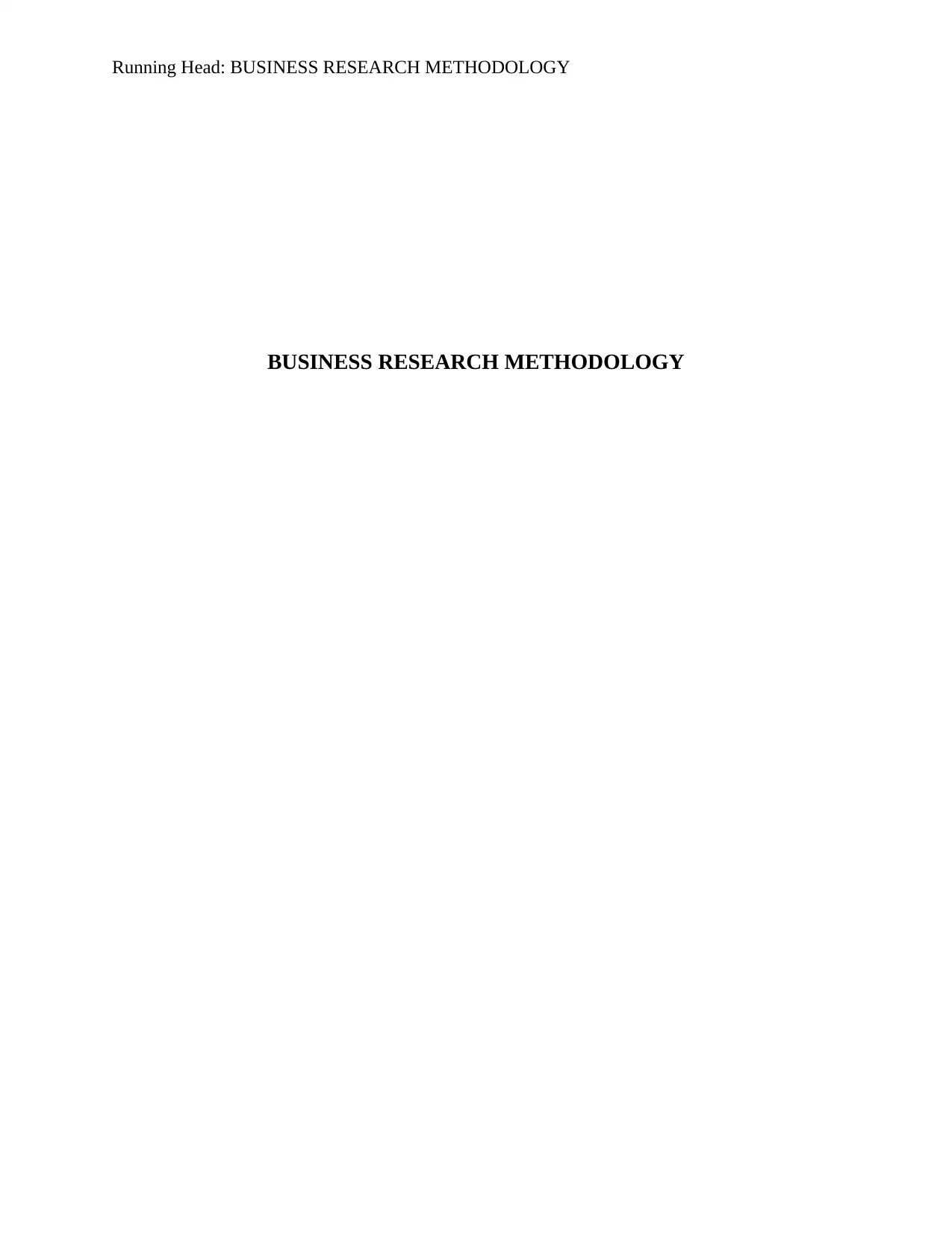
Running Head: BUSINESS RESEARCH METHODOLOGY
BUSINESS RESEARCH METHODOLOGY
BUSINESS RESEARCH METHODOLOGY
Paraphrase This Document
Need a fresh take? Get an instant paraphrase of this document with our AI Paraphraser
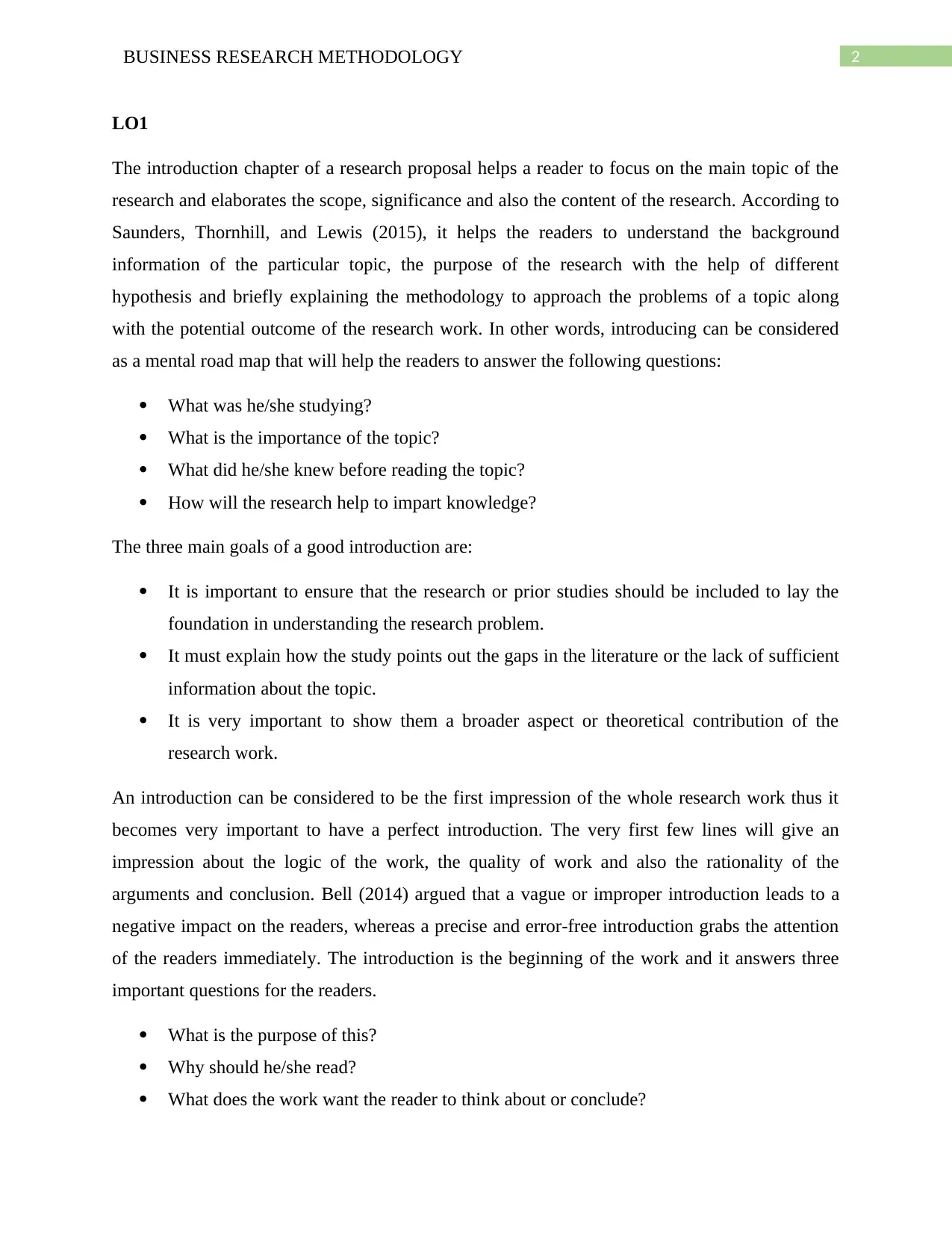
2BUSINESS RESEARCH METHODOLOGY
LO1
The introduction chapter of a research proposal helps a reader to focus on the main topic of the
research and elaborates the scope, significance and also the content of the research. According to
Saunders, Thornhill, and Lewis (2015), it helps the readers to understand the background
information of the particular topic, the purpose of the research with the help of different
hypothesis and briefly explaining the methodology to approach the problems of a topic along
with the potential outcome of the research work. In other words, introducing can be considered
as a mental road map that will help the readers to answer the following questions:
What was he/she studying?
What is the importance of the topic?
What did he/she knew before reading the topic?
How will the research help to impart knowledge?
The three main goals of a good introduction are:
It is important to ensure that the research or prior studies should be included to lay the
foundation in understanding the research problem.
It must explain how the study points out the gaps in the literature or the lack of sufficient
information about the topic.
It is very important to show them a broader aspect or theoretical contribution of the
research work.
An introduction can be considered to be the first impression of the whole research work thus it
becomes very important to have a perfect introduction. The very first few lines will give an
impression about the logic of the work, the quality of work and also the rationality of the
arguments and conclusion. Bell (2014) argued that a vague or improper introduction leads to a
negative impact on the readers, whereas a precise and error-free introduction grabs the attention
of the readers immediately. The introduction is the beginning of the work and it answers three
important questions for the readers.
What is the purpose of this?
Why should he/she read?
What does the work want the reader to think about or conclude?
LO1
The introduction chapter of a research proposal helps a reader to focus on the main topic of the
research and elaborates the scope, significance and also the content of the research. According to
Saunders, Thornhill, and Lewis (2015), it helps the readers to understand the background
information of the particular topic, the purpose of the research with the help of different
hypothesis and briefly explaining the methodology to approach the problems of a topic along
with the potential outcome of the research work. In other words, introducing can be considered
as a mental road map that will help the readers to answer the following questions:
What was he/she studying?
What is the importance of the topic?
What did he/she knew before reading the topic?
How will the research help to impart knowledge?
The three main goals of a good introduction are:
It is important to ensure that the research or prior studies should be included to lay the
foundation in understanding the research problem.
It must explain how the study points out the gaps in the literature or the lack of sufficient
information about the topic.
It is very important to show them a broader aspect or theoretical contribution of the
research work.
An introduction can be considered to be the first impression of the whole research work thus it
becomes very important to have a perfect introduction. The very first few lines will give an
impression about the logic of the work, the quality of work and also the rationality of the
arguments and conclusion. Bell (2014) argued that a vague or improper introduction leads to a
negative impact on the readers, whereas a precise and error-free introduction grabs the attention
of the readers immediately. The introduction is the beginning of the work and it answers three
important questions for the readers.
What is the purpose of this?
Why should he/she read?
What does the work want the reader to think about or conclude?
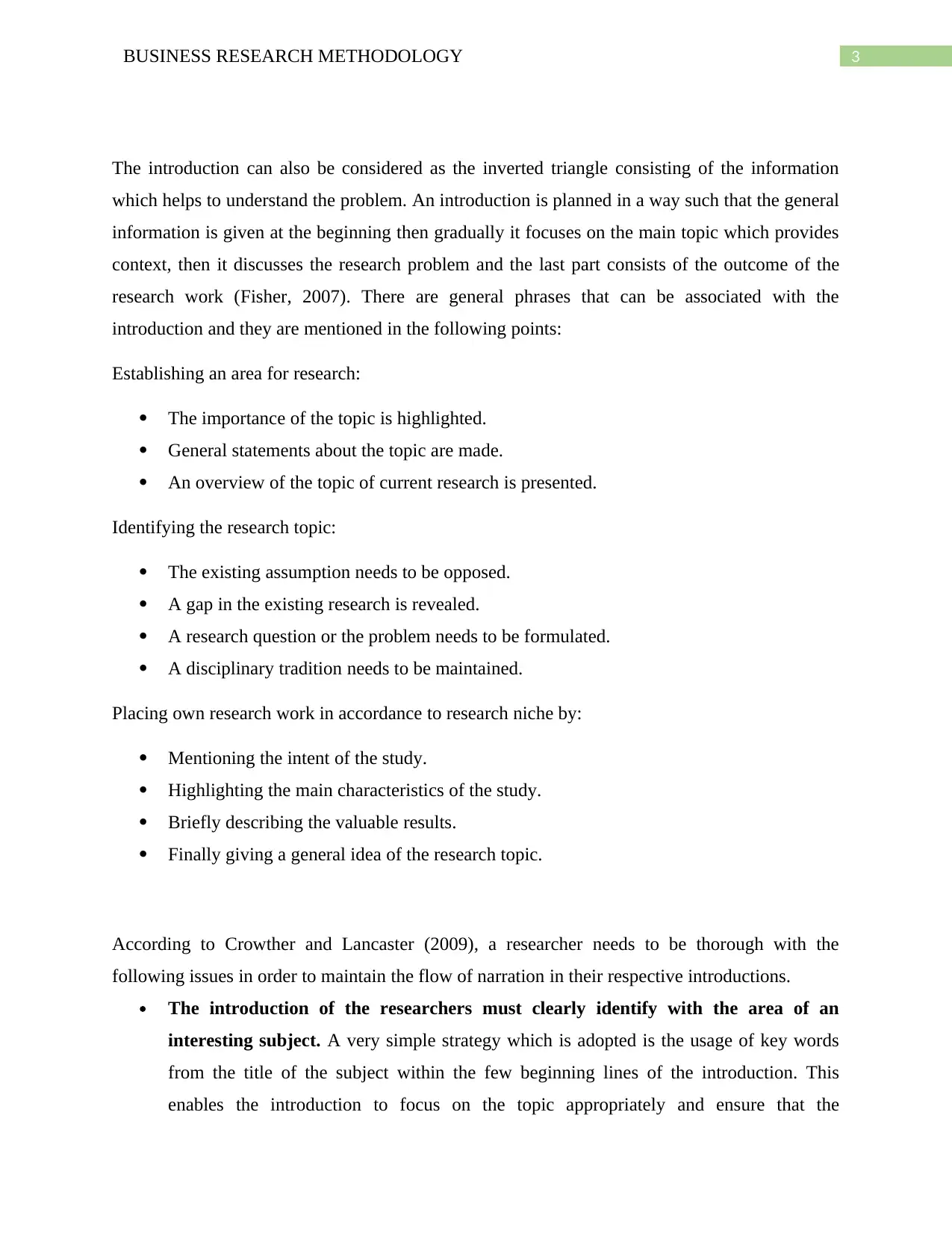
3BUSINESS RESEARCH METHODOLOGY
The introduction can also be considered as the inverted triangle consisting of the information
which helps to understand the problem. An introduction is planned in a way such that the general
information is given at the beginning then gradually it focuses on the main topic which provides
context, then it discusses the research problem and the last part consists of the outcome of the
research work (Fisher, 2007). There are general phrases that can be associated with the
introduction and they are mentioned in the following points:
Establishing an area for research:
The importance of the topic is highlighted.
General statements about the topic are made.
An overview of the topic of current research is presented.
Identifying the research topic:
The existing assumption needs to be opposed.
A gap in the existing research is revealed.
A research question or the problem needs to be formulated.
A disciplinary tradition needs to be maintained.
Placing own research work in accordance to research niche by:
Mentioning the intent of the study.
Highlighting the main characteristics of the study.
Briefly describing the valuable results.
Finally giving a general idea of the research topic.
According to Crowther and Lancaster (2009), a researcher needs to be thorough with the
following issues in order to maintain the flow of narration in their respective introductions.
The introduction of the researchers must clearly identify with the area of an
interesting subject. A very simple strategy which is adopted is the usage of key words
from the title of the subject within the few beginning lines of the introduction. This
enables the introduction to focus on the topic appropriately and ensure that the
The introduction can also be considered as the inverted triangle consisting of the information
which helps to understand the problem. An introduction is planned in a way such that the general
information is given at the beginning then gradually it focuses on the main topic which provides
context, then it discusses the research problem and the last part consists of the outcome of the
research work (Fisher, 2007). There are general phrases that can be associated with the
introduction and they are mentioned in the following points:
Establishing an area for research:
The importance of the topic is highlighted.
General statements about the topic are made.
An overview of the topic of current research is presented.
Identifying the research topic:
The existing assumption needs to be opposed.
A gap in the existing research is revealed.
A research question or the problem needs to be formulated.
A disciplinary tradition needs to be maintained.
Placing own research work in accordance to research niche by:
Mentioning the intent of the study.
Highlighting the main characteristics of the study.
Briefly describing the valuable results.
Finally giving a general idea of the research topic.
According to Crowther and Lancaster (2009), a researcher needs to be thorough with the
following issues in order to maintain the flow of narration in their respective introductions.
The introduction of the researchers must clearly identify with the area of an
interesting subject. A very simple strategy which is adopted is the usage of key words
from the title of the subject within the few beginning lines of the introduction. This
enables the introduction to focus on the topic appropriately and ensure that the
⊘ This is a preview!⊘
Do you want full access?
Subscribe today to unlock all pages.

Trusted by 1+ million students worldwide
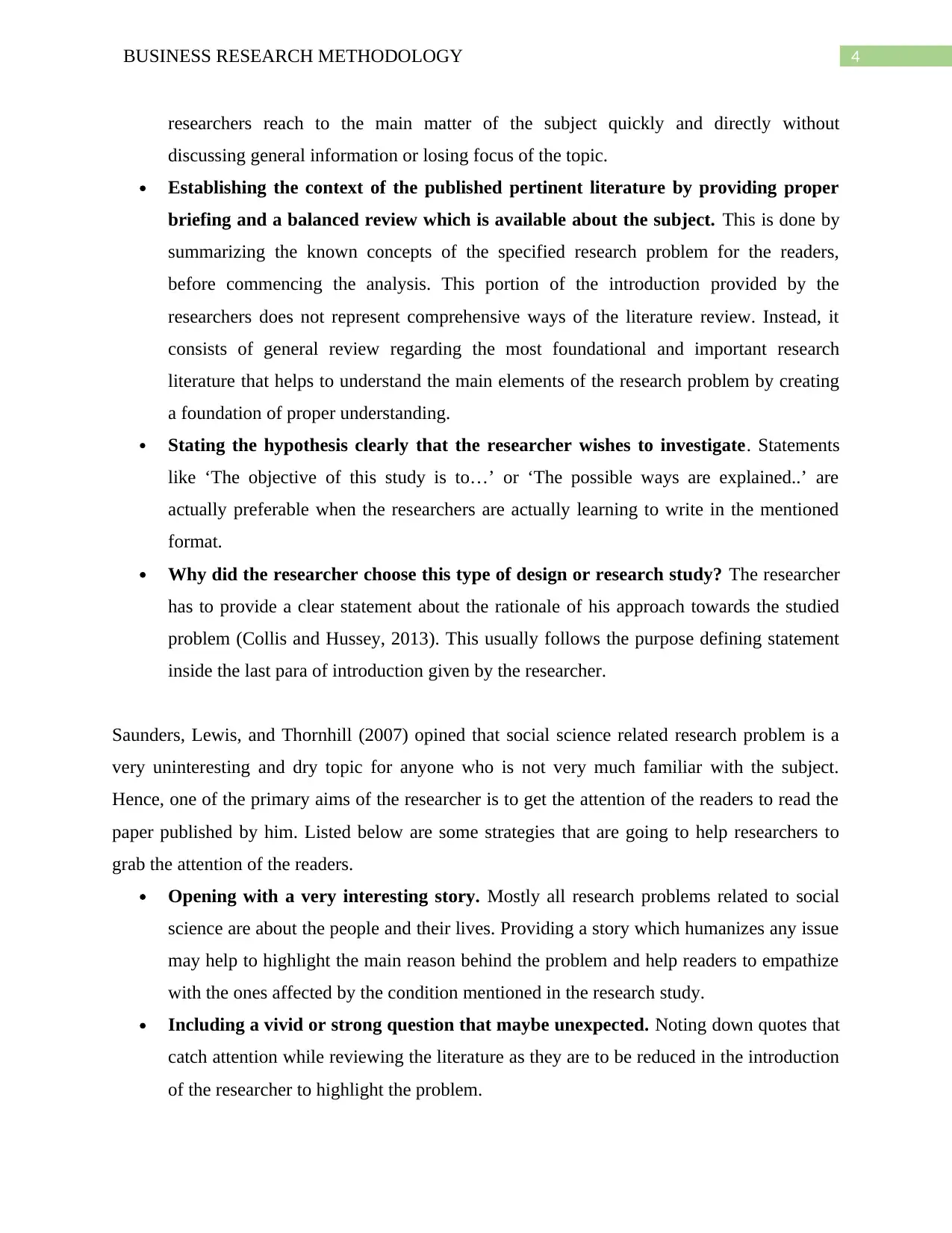
4BUSINESS RESEARCH METHODOLOGY
researchers reach to the main matter of the subject quickly and directly without
discussing general information or losing focus of the topic.
Establishing the context of the published pertinent literature by providing proper
briefing and a balanced review which is available about the subject. This is done by
summarizing the known concepts of the specified research problem for the readers,
before commencing the analysis. This portion of the introduction provided by the
researchers does not represent comprehensive ways of the literature review. Instead, it
consists of general review regarding the most foundational and important research
literature that helps to understand the main elements of the research problem by creating
a foundation of proper understanding.
Stating the hypothesis clearly that the researcher wishes to investigate. Statements
like ‘The objective of this study is to…’ or ‘The possible ways are explained..’ are
actually preferable when the researchers are actually learning to write in the mentioned
format.
Why did the researcher choose this type of design or research study? The researcher
has to provide a clear statement about the rationale of his approach towards the studied
problem (Collis and Hussey, 2013). This usually follows the purpose defining statement
inside the last para of introduction given by the researcher.
Saunders, Lewis, and Thornhill (2007) opined that social science related research problem is a
very uninteresting and dry topic for anyone who is not very much familiar with the subject.
Hence, one of the primary aims of the researcher is to get the attention of the readers to read the
paper published by him. Listed below are some strategies that are going to help researchers to
grab the attention of the readers.
Opening with a very interesting story. Mostly all research problems related to social
science are about the people and their lives. Providing a story which humanizes any issue
may help to highlight the main reason behind the problem and help readers to empathize
with the ones affected by the condition mentioned in the research study.
Including a vivid or strong question that maybe unexpected. Noting down quotes that
catch attention while reviewing the literature as they are to be reduced in the introduction
of the researcher to highlight the problem.
researchers reach to the main matter of the subject quickly and directly without
discussing general information or losing focus of the topic.
Establishing the context of the published pertinent literature by providing proper
briefing and a balanced review which is available about the subject. This is done by
summarizing the known concepts of the specified research problem for the readers,
before commencing the analysis. This portion of the introduction provided by the
researchers does not represent comprehensive ways of the literature review. Instead, it
consists of general review regarding the most foundational and important research
literature that helps to understand the main elements of the research problem by creating
a foundation of proper understanding.
Stating the hypothesis clearly that the researcher wishes to investigate. Statements
like ‘The objective of this study is to…’ or ‘The possible ways are explained..’ are
actually preferable when the researchers are actually learning to write in the mentioned
format.
Why did the researcher choose this type of design or research study? The researcher
has to provide a clear statement about the rationale of his approach towards the studied
problem (Collis and Hussey, 2013). This usually follows the purpose defining statement
inside the last para of introduction given by the researcher.
Saunders, Lewis, and Thornhill (2007) opined that social science related research problem is a
very uninteresting and dry topic for anyone who is not very much familiar with the subject.
Hence, one of the primary aims of the researcher is to get the attention of the readers to read the
paper published by him. Listed below are some strategies that are going to help researchers to
grab the attention of the readers.
Opening with a very interesting story. Mostly all research problems related to social
science are about the people and their lives. Providing a story which humanizes any issue
may help to highlight the main reason behind the problem and help readers to empathize
with the ones affected by the condition mentioned in the research study.
Including a vivid or strong question that maybe unexpected. Noting down quotes that
catch attention while reviewing the literature as they are to be reduced in the introduction
of the researcher to highlight the problem.
Paraphrase This Document
Need a fresh take? Get an instant paraphrase of this document with our AI Paraphraser
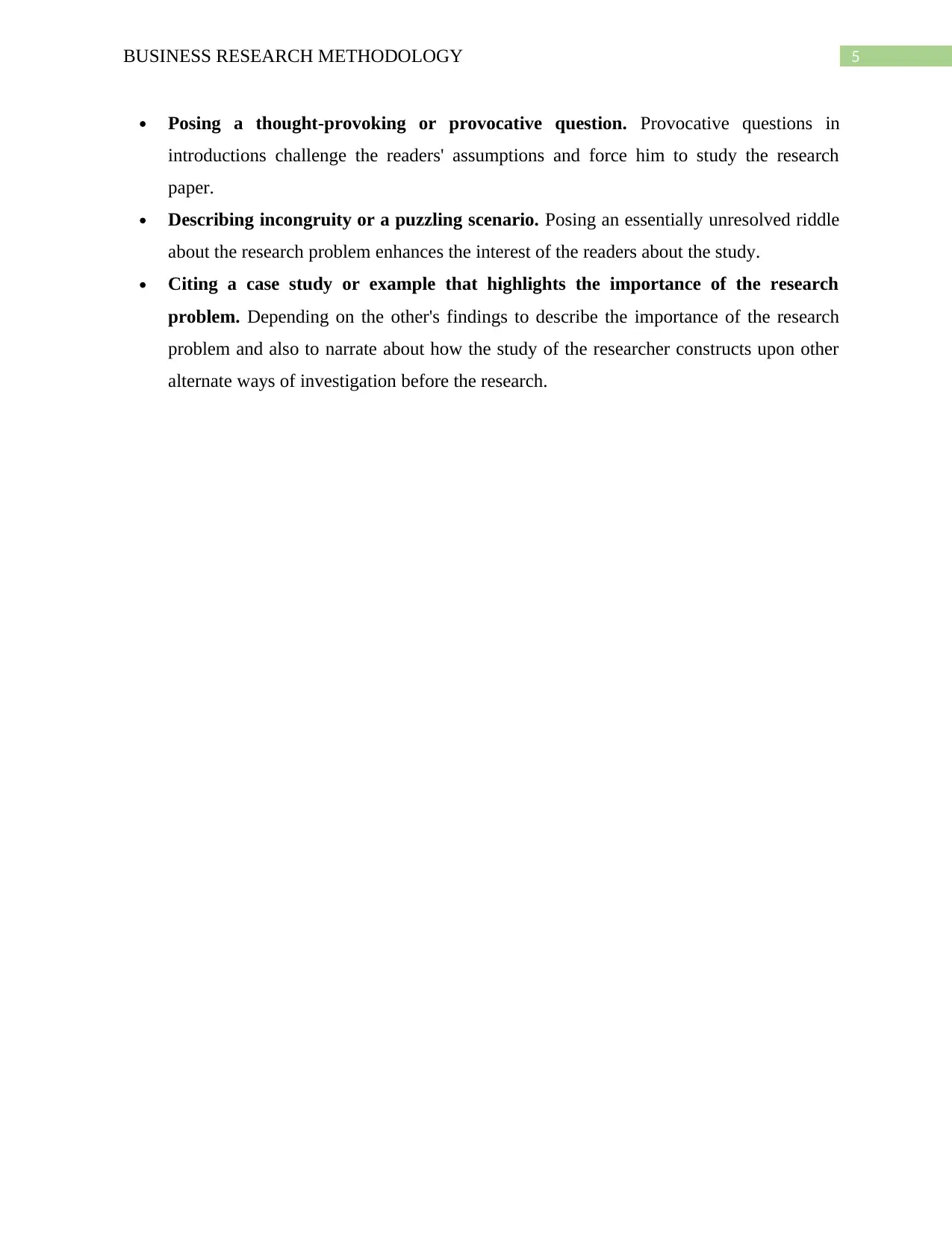
5BUSINESS RESEARCH METHODOLOGY
Posing a thought-provoking or provocative question. Provocative questions in
introductions challenge the readers' assumptions and force him to study the research
paper.
Describing incongruity or a puzzling scenario. Posing an essentially unresolved riddle
about the research problem enhances the interest of the readers about the study.
Citing a case study or example that highlights the importance of the research
problem. Depending on the other's findings to describe the importance of the research
problem and also to narrate about how the study of the researcher constructs upon other
alternate ways of investigation before the research.
Posing a thought-provoking or provocative question. Provocative questions in
introductions challenge the readers' assumptions and force him to study the research
paper.
Describing incongruity or a puzzling scenario. Posing an essentially unresolved riddle
about the research problem enhances the interest of the readers about the study.
Citing a case study or example that highlights the importance of the research
problem. Depending on the other's findings to describe the importance of the research
problem and also to narrate about how the study of the researcher constructs upon other
alternate ways of investigation before the research.

6BUSINESS RESEARCH METHODOLOGY
References
Bell, J., 2014. Doing Your Research Project: A guide for first-time researchers. McGraw-Hill
Education (UK).
Collis, J. and Hussey, R., 2013. Business research: A practical guide for undergraduate and
postgraduate students. Macmillan International Higher Education.
Crowther, D. and Lancaster, G., 2009. Research Methods in Management, Elsevier Butterworth-
Heinemann, Oxford
Fisher, F., 2007. Researching and Writing a Dissertation: for Business Students 2nd Edition, FT
Prentice Hall, Harlow
Saunders, M., Lewis, P.H.I.L.I.P. and Thornhill, A.D.R.I.A.N., 2007. Research
methods. Business Students 4th edition Pearson Education Limited, England.
Saunders, M., Thornhill, A. and Lewis, P., 2015. Research methods for Business Students, 4th
Edition, Harlow: FT Prentice Hall, 7th Edition.
References
Bell, J., 2014. Doing Your Research Project: A guide for first-time researchers. McGraw-Hill
Education (UK).
Collis, J. and Hussey, R., 2013. Business research: A practical guide for undergraduate and
postgraduate students. Macmillan International Higher Education.
Crowther, D. and Lancaster, G., 2009. Research Methods in Management, Elsevier Butterworth-
Heinemann, Oxford
Fisher, F., 2007. Researching and Writing a Dissertation: for Business Students 2nd Edition, FT
Prentice Hall, Harlow
Saunders, M., Lewis, P.H.I.L.I.P. and Thornhill, A.D.R.I.A.N., 2007. Research
methods. Business Students 4th edition Pearson Education Limited, England.
Saunders, M., Thornhill, A. and Lewis, P., 2015. Research methods for Business Students, 4th
Edition, Harlow: FT Prentice Hall, 7th Edition.
⊘ This is a preview!⊘
Do you want full access?
Subscribe today to unlock all pages.

Trusted by 1+ million students worldwide
1 out of 6
Related Documents
Your All-in-One AI-Powered Toolkit for Academic Success.
+13062052269
info@desklib.com
Available 24*7 on WhatsApp / Email
![[object Object]](/_next/static/media/star-bottom.7253800d.svg)
Unlock your academic potential
Copyright © 2020–2025 A2Z Services. All Rights Reserved. Developed and managed by ZUCOL.





